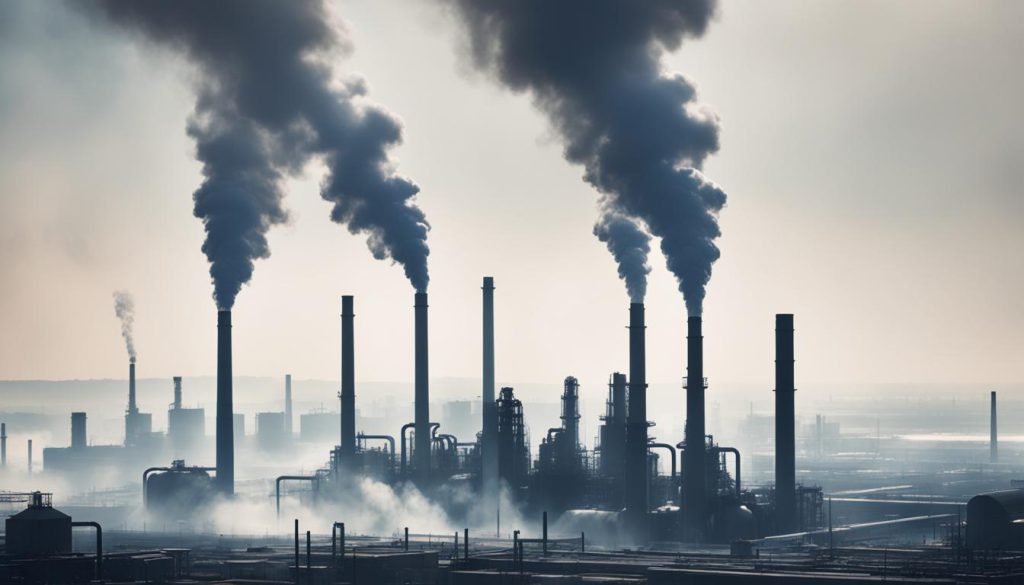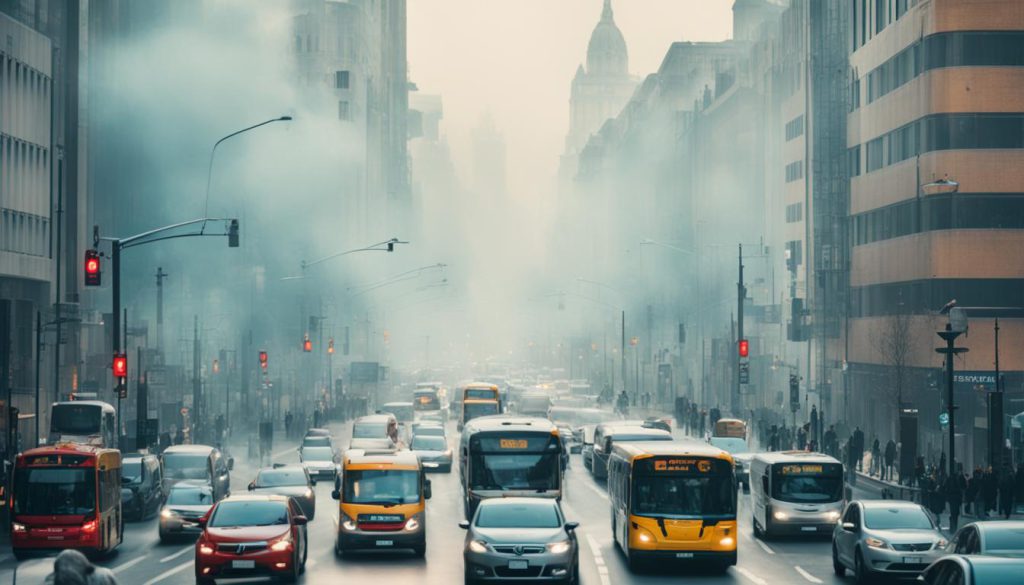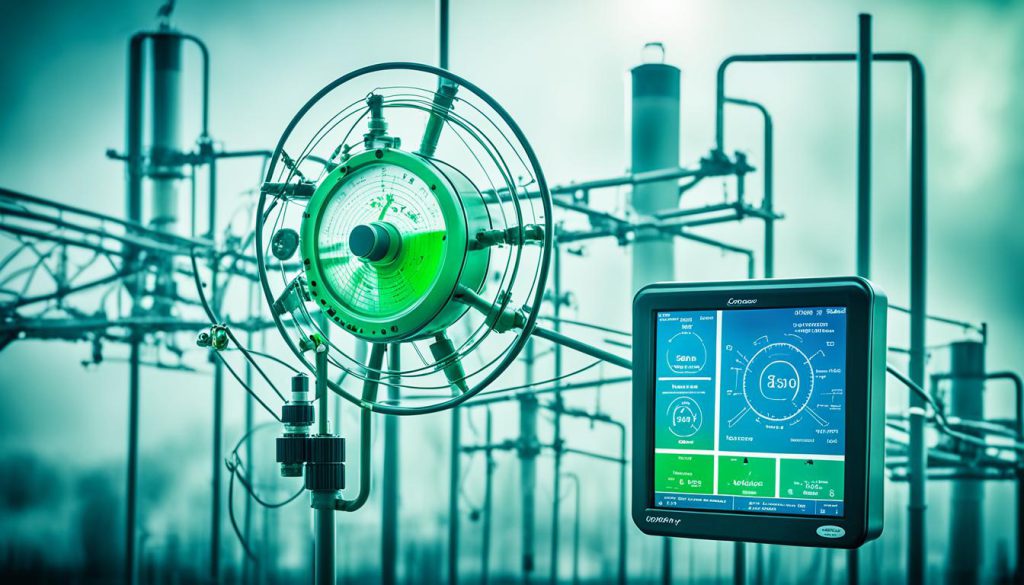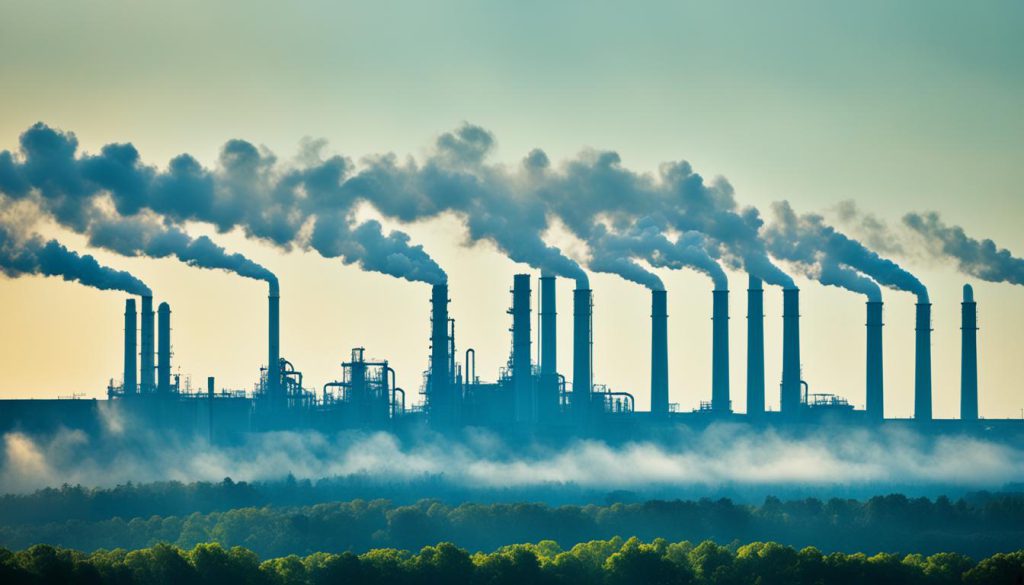Air pollution is behind around 7 million early deaths each year worldwide. It greatly affects our health and the planet. This makes controlling air quality very important for clean, healthy air.
In the USA, air quality rules are set by both federal and state governments. These laws aim to keep us and the environment safe. By setting limits on emissions and using pollution control, these rules help ensure the air stays clean.
Key Takeaways:
- Air quality regulation is essential to protect public health and the environment.
- Federal and state laws govern air quality regulation in the USA.
- Emission standards and pollution control measures are key components of air quality regulation.
- Air pollution has a significant impact on global health, causing millions of premature deaths annually.
- Navigating air quality regulation is crucial for creating cleaner and healthier environments.
Emission Standards
Emission standards are key to keeping our air clean. These rules, made by the government, limit air pollutants. They make sure industries and people follow the rules, helping reduce pollution and protect our health.
These standards are different for each industry or pollution source. For example, power plants have different rules than car makers. They limit harmful pollutants like particulate matter and nitrogen oxides. The goal is to lessen their bad effects on air quality.
Following these standards is critical for clean air and less pollution. Industries must use pollution control methods and new technologies to meet these standards. The EPA checks and makes sure industries do what they’re supposed to do. They conduct inspections and audits regularly.
By following these rules, we all help make the environment better and healthier. These standards protect both our health and nature’s ecosystems. With everyone’s effort, including industries, individuals, and the government, we can fight air pollution together. And pave the way for a greener future.
Indoor Air Quality
The air inside buildings affects our health and comfort a lot. When the air quality is poor, it can make us sick and feel uncomfortable. It’s important to make indoor air clean and safe for everyone.
Setting rules for clean air indoors is very important. These rules help make the air in buildings healthier. They include things like making sure buildings have good airflow, not allowing smoking inside, and using materials that don’t pollute the air.
Good ventilation is key to keeping indoor air fresh. It gets rid of pollutants and brings in clean air. Rules about how to set up and take care of ventilation systems help keep the air in buildings clean.
Not allowing smoking inside helps everyone breathe easier. Rules against indoor smoking protect us from the bad effects of breathing in smoke from others. This makes indoor spaces nicer and healthier for all.
Pollutants like certain chemicals can also make indoor air unhealthy. Rules might require using safer materials in building and upkeep. This reduces dangerous chemicals in the air, making indoor spaces healthier.

It’s very important to have good air quality inside for our health. By following rules for clean air, we make indoor places safe and healthy. Ventilation, no smoking, and controlling pollutants are part of these rules. We should all support clean air rules to keep our indoor spaces healthy.
Benefits of Clean Air Policies for Indoor Air Quality
- Promote respiratory health by reducing exposure to harmful pollutants
- Create a comfortable and pleasant indoor environment
- Protect vulnerable populations, such as children and the elderly, from the negative effects of poor indoor air quality
- Reduce the risk of respiratory conditions and allergies
- Enhance productivity and well-being in indoor spaces
Indoor Air Quality Guidelines
| Guideline | Description |
|---|---|
| Ventilation Systems | Proper design, installation, and maintenance of ventilation systems to ensure a constant supply of fresh air and removal of pollutants |
| Smoking Restrictions | Restrictions or prohibition of smoking indoors to reduce exposure to secondhand smoke |
| Low-Emission Materials | Use of building materials and products with low emissions of harmful chemicals to minimize indoor pollutant levels |
Industrial Air Pollution
Industrial air pollution comes from releasing pollutants during manufacturing. These pollutants can hurt air quality and public health. To fight this pollution, it’s important for industries to follow rules and use pollution control.
The Environmental Protection Agency (EPA) enforces these rules. The EPA sets emission standards to protect air quality. It checks that companies follow these standards to cut down on pollution.
“Regulatory compliance is essential to effectively control industrial air pollution and safeguard public health.” – Environmental Protection Agency (EPA)
Companies must meet emission limits and use pollution control technology. By using cleaner technologies, industries can lessen their environmental impact. This helps improve air quality.
Here’s how industrial air pollution and rule-following matters:
| Industrial Sector | Emission Level (tons/year) |
|---|---|
| Chemical Manufacturing | 250,000 |
| Power Generation | 700,000 |
| Oil Refining | 350,000 |
| Steel Production | 450,000 |
These numbers show major emissions from key industries. With strong rules and enforcement, we can reduce these emissions. This makes the air cleaner for everyone.

To tackle industrial air pollution, everyone must work together. By following rules, industries can lower their damage to air quality. With ongoing checks and enforcement, we aim for a cleaner environment for us and the future.
Vehicle Emissions
Vehicle emissions heavily contribute to air pollution, mainly in cities. Cars and trucks burn fossil fuels, releasing harmful pollutants. Governments have set clean air rules and emissions standards to fight this.
These efforts aim to cut down vehicle emissions. They do this by setting standards, requiring emissions tests, and encouraging clean transport. Such steps include incentives for electric and hybrid vehicles and public transit.
By setting emission standards, limits are placed on pollutants cars can emit. These pollutants include carbon monoxide and nitrogen oxides. They harm our health and contribute to smog.
Vehicles must pass emissions tests to show they meet these standards. This happens during registration or inspection. It helps find and fix vehicles that pollute too much.
Clean air policies push for cleaner, sustainable travel options. Incentives like tax breaks and carpool lanes boost the use of cleaner vehicles. This leads to fewer harmful emissions on our roads.
With these regulations, governments hope to better air quality. They aim to reduce health risks from pollution and move towards a greener future.

The Link Between Vehicle Emissions and Air Quality
Vehicle emissions significantly worsen air quality. These emissions mix with sunlight, creating harmful ozone and fine particles. These can cause or worsen respiratory issues and heart diseases.
Cities are especially at risk due to crowded roads and many cars. This situation exposes people to more pollutants, hurting both drivers and walkers.
To combat this, we need strict emission rules and clean air policies. Cutting vehicle emissions can make our cities healthier and more sustainable.
| Benefits of Clean Air Policies and Emission Regulations | Examples |
|---|---|
| Improved air quality | Reduction in smog formation |
| Healthier communities | Decreased respiratory problems |
| Sustainable transportation | Promotion of electric and hybrid vehicles |
| Reduced greenhouse gas emissions | Contribution to climate change mitigation |
Air Quality Monitoring
Air quality monitoring is key to keeping our air clean and safe. Stations with high-tech tools measure pollutants in the air. This data helps find where pollution comes from and how to stop it. Governments use this info to make rules that protect our health and the planet.
When we monitor air regularly, we can spot places with harmful air. This lets us act fast to make the air better. Keeping track of air quality helps us meet standards and protect our health. This way, we work together to keep the air clean for everyone.

The Importance of Monitoring
Monitoring air quality tells us how pollution affects our world. It shows us if we’re fighting pollution effectively. The data drives policies, aiming to tackle pollution in specific areas or industries.
“Air quality monitoring is a critical tool in the pursuit of cleaner, safer air. By collecting and analyzing robust data, we can effectively address air pollution challenges, implement more effective regulations, and safeguard public health.”
Ensuring Regulatory Compliance
Meeting air quality laws is crucial. It helps reduce pollution’s bad effects and keeps the environment safe. Through monitoring, we spot where the rules aren’t being followed. This lets authorities enforce the rules and make sure everyone complies.
By keeping an eye on compliance, we call out polluters. We encourage clean tech and methods. This improves air quality and pushes us towards a sustainable, green future.
Collaborative Efforts for Cleaner Air
Improving air quality is a team effort involving government, science, and community. Together, we use data and expertise to fight air pollution. This teamwork gives us a deeper insight into air quality issues and better ways to fix them.
- Government agencies can use monitoring data to inform the development of air quality regulations and policies.
- Scientific institutions can conduct research and analysis to enhance our understanding of air pollution and its impacts on human health and the environment.
- Communities can actively participate in monitoring initiatives and advocate for clean air policies that prioritize public health and well-being.
Through cooperation, we move closer to a world with cleaner air. This protects our environment and ensures a healthy future for the next generations.
Cross-Border Air Pollution
Air pollution doesn’t stop at borders. It can move between regions, countries, and continents. We face a big challenge with cross-border pollution. It needs international teamwork and clean air rules that go beyond one nation’s borders.
To fight cross-border air pollution, countries need to work as one. They should find and lessen pollution sources. Sharing knowledge and resources, nations can come up with plans. These plans can reduce pollution’s global impact.
International deals and team efforts are key to managing cross-border pollution. These agreements set up ways for countries to work together. They share information and successful methods. Together, they aim to make the air cleaner.
Clean air policies are crucial in tackling cross-border pollution. Countries have to set tough pollution limits. They must support green habits and spend money on controlling pollution. This can cut down the pollutants that go into the air. It lessens harmful effects on humans and the environment.
Collaborating is vital to fight cross-border air pollution. By uniting, nations can aim to protect air quality. They aim to keep the environment clean and keep people healthy.
The Need for International Cooperation
Working together globally is essential to handle cross-border air pollution for many reasons:
- Global Impact: Cross-border pollution affects many countries, not just where it starts. Global teamwork is needed to handle air pollution’s wide effects and improve air quality everywhere.
- Shared Responsibility: Fighting air pollution is a common duty. International cooperation helps countries see their part in it. Together, they can make strategies for cleaner air for all.
- Knowledge Exchange: Countries working together can share what they know. This lets them learn from each other’s successes and problems. It leads to better ways to manage air quality.
- Joint Research and Development: By doing research together, countries can find new ways to reduce air pollution. Sharing resources and knowledge speeds up creating clean technologies and green practices.
| Benefits of International Cooperation in Managing Cross-Border Air Pollution |
|---|
| 1. Enhanced data sharing for accurate air quality assessments |
| 2. Strengthened enforcement of emission standards and regulations |
| 3. Improved understanding of pollution sources and their impacts |
| 4. Increased funding and resources for air quality monitoring and control |
| 5. Harmonized approaches to air pollution management and policy development |
| 6. Facilitated technology transfer for cleaner and more sustainable industries |
The image shows how air pollution connects different countries. It reminds us why we need to work together internationally. With clean air policies, we can improve air quality worldwide.
Regulation of Volatile Organic Compounds (VOCs)
Volatile Organic Compounds, or VOCs, are chemicals bad for air quality and our health. Governments have set strict rules to limit VOC emissions and improve air control. It’s vital for industries using VOCs to follow these rules closely, helping to reduce air pollution.
VOCs are found in many areas like manufacturing and construction. They come from products we use often like paints and solvents. With such widespread use, it’s crucial to have strong rules to limit their emissions.
By controlling VOC emissions, we aim to protect the air we breathe and our health. Emission standards help by setting limits on VOCs released into the air. Pollution control measures also promote the use of cleaner technologies, leading to better production methods.
Benefits of Regulating VOCs:
- Improved air quality: Regulation of VOCs aids in reducing the concentration of harmful pollutants in the air, leading to improved air quality for communities.
- Public health protection: By reducing VOC emissions, regulations help safeguard public health, preventing respiratory issues, allergies, and other ailments associated with poor air quality.
- Environmental sustainability: Implementing emission standards and pollution control measures ensures the preservation of the environment and the conservation of natural resources.
- Innovation and technology advancement: VOC regulations drive the development and adoption of cleaner technologies and practices, fostering innovation and creating new opportunities in the industry.
Regulating VOCs is vital for protecting our air and health. By setting emission limits and using pollution control, we can cut down harmful chemical release. This ensures a cleaner, healthier future for everyone.

Conclusion
Air quality rules in the USA are designed to keep our health and the planet safe. They include laws and policies that control air pollution. These efforts make sure we all have clean air to breathe.
Following these rules is very important. It lessens the harm of air pollution on us and our world. By sticking to these rules and using pollution control, we can make our environment healthier. This helps improve the air around us.
Everyone needs to understand and follow air quality rules. When we stay informed and take action, we help protect the air. By working together, we can ensure clean air for the future. Let’s all do our part for cleaner air and a better tomorrow.
